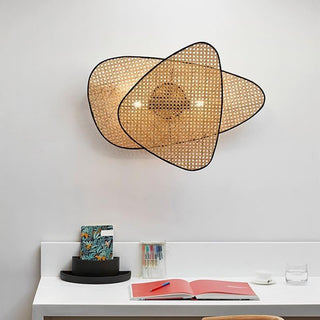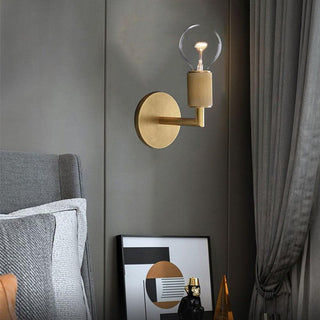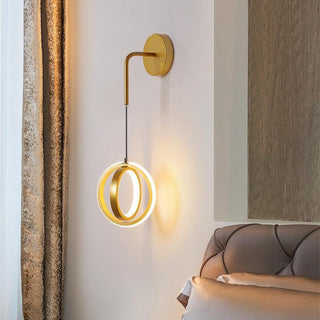The days of judging light bulbs by their wattage alone are over. Modern lighting has shifted focus to lumens, a measure of brightness, making it easier to find the right bulb for your needs while saving energy.
This shift not only enhances energy-saving lighting solutions but also allows for better understanding of terms like lumens and luminous intensity.
Let’s break down the key differences, why they matter, and how to choose the perfect bulb for your home or workspace.
1. What are lumens and watts?

What does Lumen mean on a lightbulb?
Lumen (often noted "lm") is the unit of measurements for luminous intensity. In other words, it measure the total amount of visible light emitted by a light source (usually a light bulb).
Think of it as the brightness level you can see. For example, a higher lumen rating means a brighter light, whether it’s for your living room or outdoor landscape. LED bulbs often produce more lumens per watt, making them an energy-efficient choice for most spaces.
How are lumens measured?
The process of measuring lumens typically involves using an integrating sphere, a device that captures all the light emitted from a bulb or lamp to calculate its total luminous output. This result is expressed in lumens, providing a reliable measurement unit for comparing the brightness of different light sources.
That said, you usually don’t need to measure lumens yourself. When buying a lightbulb, the lumen rating is conveniently listed on the packaging.
What do Watts represent?
Watts measure the power consumed by a bulb to produce light.
In the past, wattage was used to estimate brightness. A 60-watt incandescent bulb, for instance, typically produced enough light for a small room. This worked because incandescent bulbs had a consistent relationship between power consumption and brightness—the more watts, the more lumens. However, this relationship doesn’t hold true for modern lighting solutions like LEDs and CFLs., which offer brighter light at a fraction of the wattage.
2. Lumens vs. watts: key differences

The main difference between lumens and watts is their focus: lumens measure light output, while watts measure energy consumption.
Modern LED technology breaks the old “more watts = brighter light” rule. This means you can replace traditional incandescent bulbs with LEDs for better efficiency without sacrificing brightness.
Why switch to lumens?
Switching to lumens helps you focus on brightness rather than power consumption. This is especially important with energy-saving technologies like compact fluorescent lamps (CFLs) and LEDs.
For example, a 10-watt LED can produce the same lumen output as a 60-watt incandescent bulb, saving a lot on electricity bills.
The efficiency factor: lumens per watt
Lumens per watt (lm/W) is the ratio of brightness to energy consumed, and it’s a key metric for determining energy efficiency. In other words, it's the amount of light a lightbulb can produce by using a given quantity of energy.
Example: comparing the efficiency of LED vs incandescend lightbulb
LEDs are leading the way with high efficacy ratings, often reaching 100 lm/W or more. Compare this to traditional incandescent lamps, which typically produce roughly 10 lm/W.
This means that a LED light bulb consumes around ten times as little energy to produce the same brightness. This makes LEDs not only efficient but also cost-effective over time.
Luminous efficency per light bulb tyle
Here’s a quick comparison table for the most common bulb types:
| Bulb Type | Luminous Efficiency (lm/W) |
|---|---|
| Incandescent | 10 to 15 |
| Halogen | 15 to 25 |
| CFL | 35 to 60 |
| Fluorescent | 50 to 100 |
| Metal halide | 75 to 100 |
| LED | 80 to 160 |
How to convert lumen to watt?
To convert lumens to watts (or vice versa), you need to know the luminous efficacy of the bulb, which depends on its type (e.g., incandescent, halogen, LED). Luminous efficacy is a measure of how efficiently a bulb converts power into light.
Formula
To convert lumens to Watt, simply divide the amount of lumen produced by the bulb by its luminous efficiency. The formula is:
Watts = Lumens ÷ Luminous Efficiency (lm/W)
For example, if a bulb emits 800 lumens and has an efficacy of 80 lm/W (typical for LEDs):
Watts = 800 ÷ 80 (lm/W) = 10W
Online calculator
If you’d rather skip the math, try an online calculator like this one by The Calculator Site. It’s simple, accurate, and quick to use.
Lumens equivalent to watt
Here is a table showing the estimated watt consumption for different bulb types based on varying lumen values.
| Lumens | Incandescent | Halogen | CFL | Fluorescent | Metal Halide | LED |
|---|---|---|---|---|---|---|
| 450 lm | 30W - 45W | 18W - 30W | 8W - 13W | 5W - 9W | 5W - 6W | 3W - 6W |
| 1000 lm | 67W - 100W | 40W - 67W | 17W - 29W | 10W - 20W | 10W - 13W | 6W - 13W |
| 2000 lm | 133W - 200W | 80W - 133W | 34W - 57W | 20W - 40W | 20W - 27W | 13W - 25W |
| 4000 lm | 267W - 400W | 160W - 267W | 68W - 114W | 40W - 80W | 40W - 54W | 25W - 50W |
3. Choosing the right bulb for your space

How many lumens do you need?
Choosing the right bulb starts with understanding your space and its specific lighting needs. The amount of light required varies depending on the room and its purpose. Here’s a guide to help you determine the ideal lumen levels:
-
Bedroom: 1,000–2,000 lumens
Bedrooms are spaces for relaxation. Soft, warm lighting works best, creating a calm atmosphere. For reading or focused tasks, you might need brighter task lighting. -
Living room: 1,500–3,000 lumens
Living rooms are versatile and require a mix of lighting. Use softer light for relaxing and brighter options for activities like reading or socializing. Divide the lighting into layers for flexibility. -
Bathroom: 2,000–4,000 lumens
Bathrooms need bright, even lighting for tasks like grooming or shaving. LED bulbs work well, especially around mirrors, as they provide clear and consistent illumination. -
Outdoor lighting: 1,500–4,000 lumens
Outdoor areas like patios and gardens need variable lighting. Softer light creates a welcoming ambiance, while brighter light improves safety and security. LED or metal halide bulbs are often ideal for these spaces. -
Kitchen: 4,000–6,000 lumens
Kitchens are task-heavy spaces that need bright, focused lighting. High-lumen LED lights provide clear visibility for cooking and cleaning. Additional task lighting on countertops is often helpful. -
Commercial spaces: 5,000–10,000 lumens (or more)
Commercial areas like offices, warehouses, and shops require consistent, bright lighting to ensure productivity and safety. LEDs are the best choice for their high efficiency and cost savings over time.
By understanding your room’s requirements, you can determine the right lumen level for each space. Modern LEDs provide the best balance of brightness, energy savings, and durability, making them a great choice for both residential and commercial lighting.
Color temperature matters
Another important factor is color temperature, measured in Kelvin (K). Warm white light (2,700–3,000K) creates a cozy ambiance, while daylight bulbs (5,000–6,500K) are great for tasks requiring focus, like reading or cooking.
For a deeper dive into color temperature, its effect on a room, and tips for selecting the best color temperature for each space, check out our complete guide: Color Temperature 101.
4. Making the switch from incandescent to LED

By reading this article, you've learned that LED bulbs are significantly more energy-efficient. For the same amount of light output, an LED bulb can consume up to 10 times less energy than an incandescent bulb.
If this has inspired you to replace your old incandescent bulbs with more efficient LEDs, here are a few tips to guide you through the transition.
Step by step guide
Check the label: Look for the lumens rating, not just wattage. Most LED bulbs include this on the lighting facts label.
Use a conversion chart: If you’re switching from incandescent to LED, use a lumens-to-watts conversion chart.
Select the right color temperature: Warm white for relaxing areas, daylight for task-focused spaces.
Consider the fixture: Ensure the bulb fits your lamp or fixture and meets its rated wattage requirements.
Why this matters for the environment
Switching to LED lighting reduces energy consumption and greenhouse gas emissions. LEDs last longer, consume less power, and produce less heat than traditional incandescent or halogen bulbs. Over decades, this shift has contributed to significant savings in electricity usage globally.
Final thoughts
Understanding the difference between lumens and watts is essential for making smart lighting choices. By focusing on lumens, color temperature, and efficiency, you can select the right bulb for any task, save energy, and create the perfect ambiance in your home or office. Ready to make the switch? It’s easy, cost-effective, and a bright idea for the planet.
Frequently asked questions
Do more watts mean brighter light?
No. With LEDs, a lower wattage can produce more lumens than a traditional incandescent bulb. It’s all about efficiency.
Are all LEDs the same?
Not quite. Quality varies by manufacturer. Check the product’s luminous efficacy and color rendering index (CRI) to ensure you’re getting a bright, efficient light source.
How many lumens is a 60-watt bulb?
A 60-watt incandescent bulb typically produces around 800 lumens. However, with energy-efficient bulbs like LEDs or CFLs, a 60-watt equivalent bulb can produce much more light (up to 800 lumens or more) while consuming significantly less power.
How many lumens is a 100-watt bulb?
A standard 100-watt incandescent bulb emits around 1600 lumens. Energy-efficient bulbs like LEDs or CFLs can offer the same brightness while consuming much less power, making them a more energy-efficient choice.
How bright is 1000 lumens?
1000 lumens is considered bright for general lighting. It’s roughly equivalent to the brightness of a 75-100-watt incandescent bulb, providing ample light for small to medium-sized rooms like bedrooms or living rooms.
How bright is 2000 lumens?
2000 lumens is quite bright and typically suitable for larger rooms or spaces with high lighting demands. It is about the brightness of a 150-watt incandescent bulb, ideal for spaces like large living rooms or dining rooms.
How bright is 4000 lumens?
4000 lumens is very bright and is suitable for areas that require high light intensity, such as kitchens, large living rooms, or workspaces. It’s approximately equivalent to four 100-watt incandescent bulbs or a single high-efficiency LED light source.
How many lumens is sunlight?
Sunlight provides around 10,000 to 100,000 lumens per square meter on a sunny day. However, this can vary depending on weather conditions and the time of day. It’s important to note that sunlight is far more intense than artificial lighting, even at its lowest levels.
How does lumens compare to candle power?
Lumens and candle power both measure light intensity, but they differ in how the light is distributed. Lumens measure the total amount of visible light emitted by a light source in all directions, while candle power (or candelas) measures the light emitted in a specific direction. Essentially, lumens give a broader idea of light output, while candle power focuses on light intensity in one direction. One candela is roughly equivalent to the light emitted by a single candle, whereas lumens offer a more comprehensive measurement of total light output.



